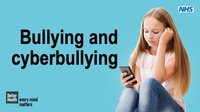Bullying and cyberbullying — Year 6 lesson plan
Developed with teachers and NHS-approved, this lesson helps pupils explore the meaning and impact of bullying and cyberbullying and how they can find support and advice.
The lesson also includes a quiz to help pupils consider what they could do in the different scenarios presented.
Curriculum
Supports the Relationships Education and Health Education statutory guidance
Respectful relationships
- about different types of bullying (including cyberbullying), the impact of bullying, responsibilities of bystanders (primarily reporting bullying to an adult) and how to get help
Online relationships
- that the same principles apply to online relationships as to face-to-face relationships, including the importance of respect for others online including when we are anonymous
- the rules and principles for keeping safe online, how to recognise risks, harmful content and contact, and how to report them
Mental wellbeing
- that bullying (including cyberbullying) has a negative and often lasting impact on mental wellbeing
Internet safety and harms
- that the internet can also be a negative place where online abuse, trolling, bullying and harassment can take place, which can have a negative impact on mental health
- how to consider the effect of their online actions on others and know how to recognise and display respectful behaviour online and the importance of keeping personal information private
Supports the PSHE curriculum
KS2
Core theme 1: Health and Wellbeing
- H20 — strategies to respond to feelings, including intense or conflicting feelings; how to manage and respond to feelings appropriately and proportionately in different situations
- H42 — about the importance of keeping personal information private; strategies for keeping safe online, including how to manage requests for personal information or images of themselves and others; what to do if frightened or worried by something seen or read online and how to report concerns, inappropriate content and contact
Core theme 2: Relationships
- R18 — to recognise if a friendship (online or offline) is making them feel unsafe or uncomfortable; how to manage this and ask for support if necessary
- R19 — about the impact of bullying, including offline and online, and the consequences of hurtful behaviour
- R20 — strategies to respond to hurtful behaviour experienced or witnessed, offline and online (including teasing, name-calling, bullying, trolling, harassment or the deliberate excluding of others); how to report concerns and get support
- R21 — about discrimination: what it means and how to challenge it
- R22 — about privacy and personal boundaries; what is appropriate in friendships and wider relationships (including online)
- R23 — about why someone may behave differently online, including pretending to be someone they are not; strategies for recognising risks, harmful content and contact; how to report concerns
- R30 — that personal behaviour can affect other people; to recognise and model respectful behaviour online
Core Theme 3: Living in the wider world
- L11 — recognise ways in which the internet and social media can be used both positively and negatively
- L15 — recognise things appropriate to share and things that should not be shared on social media; rules surrounding distribution of images
Learning outcomes
After this lesson, pupils will be able to:
- identify the meaning of bullying and cyberbullying and describe the impact it can have on a person
- explore how young people can deal with bullying and cyberbullying safely
- explain how to find support and advice on bullying and cyberbullying
More information on how to use these lesson plans in the classroom is available on the PSHE Association website.
Resource details
- Topics: Schools
- Target audience: Students and teachers
- Published: 22 August 2024
- Last updated: 7 August 2024
